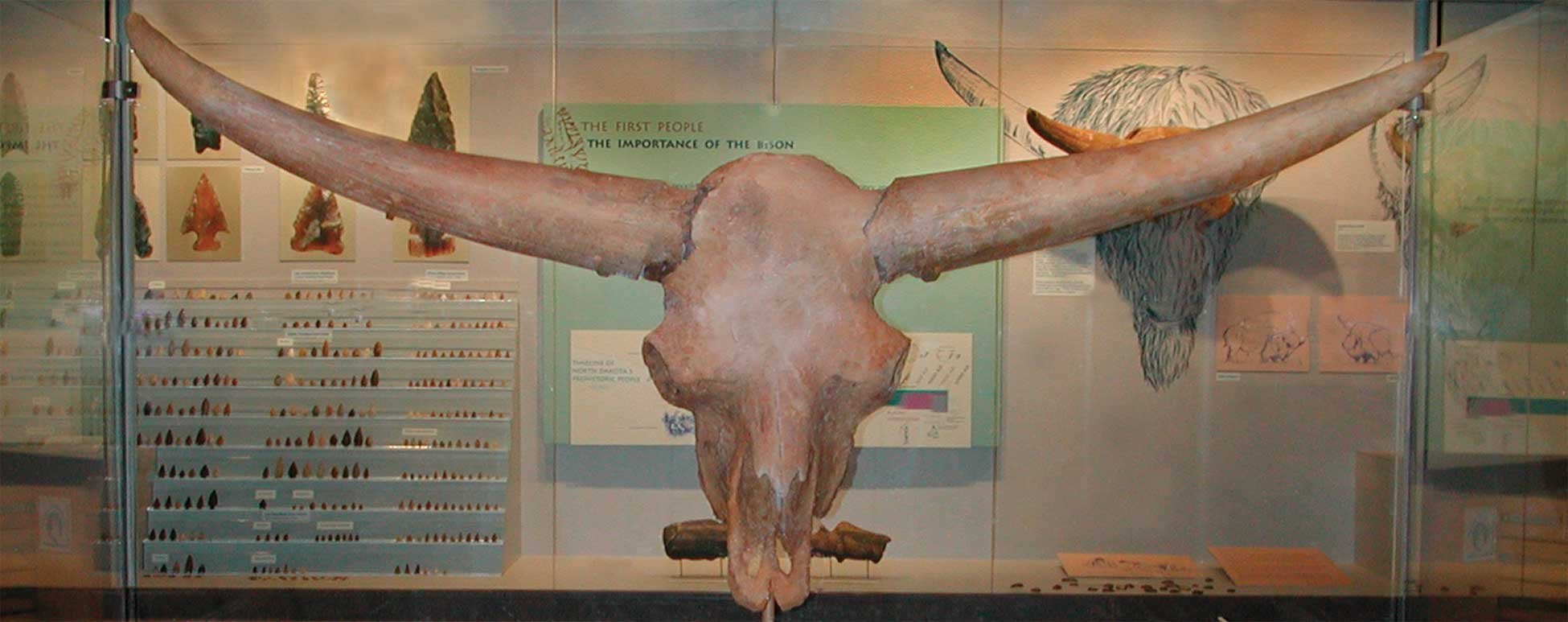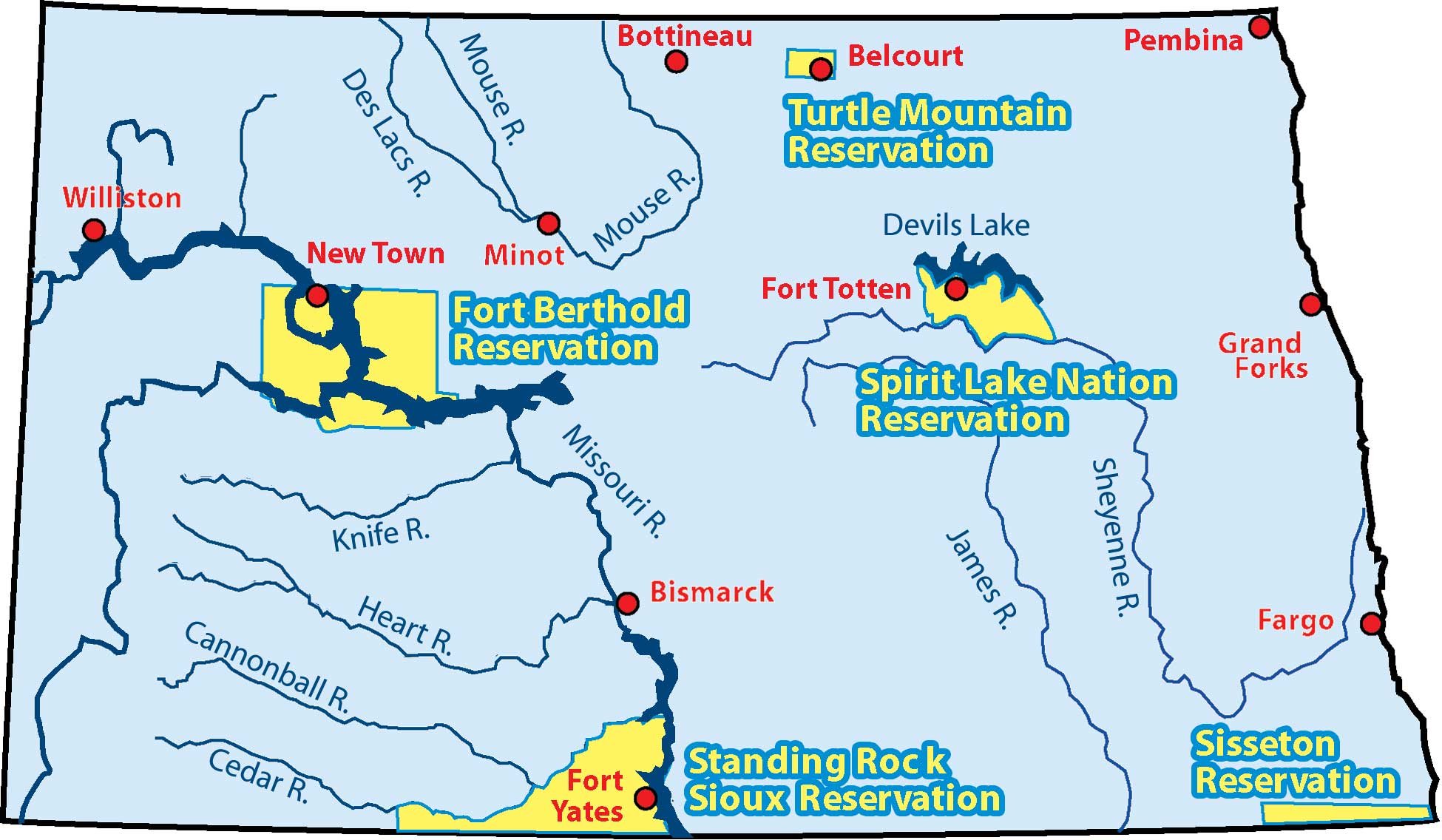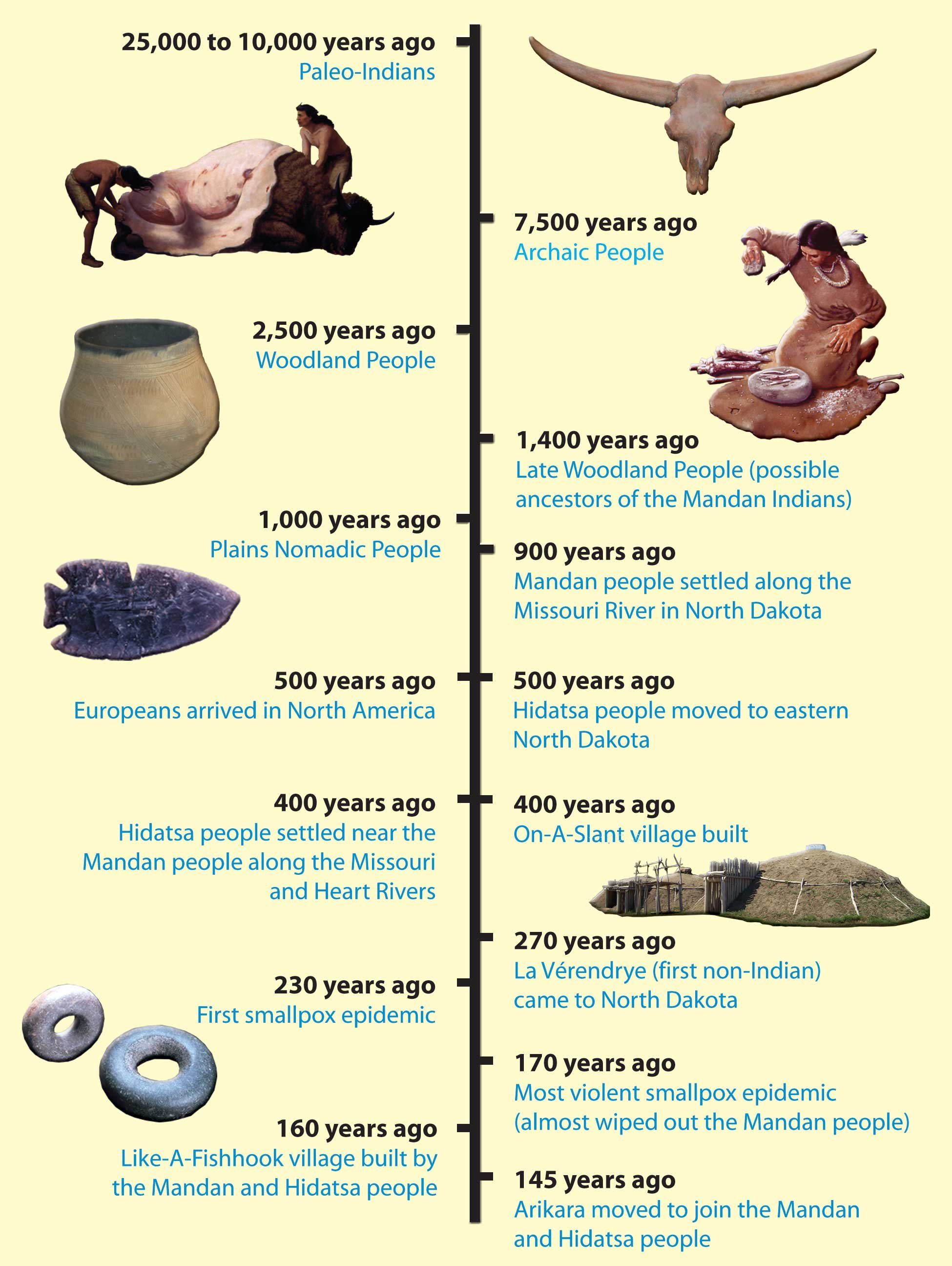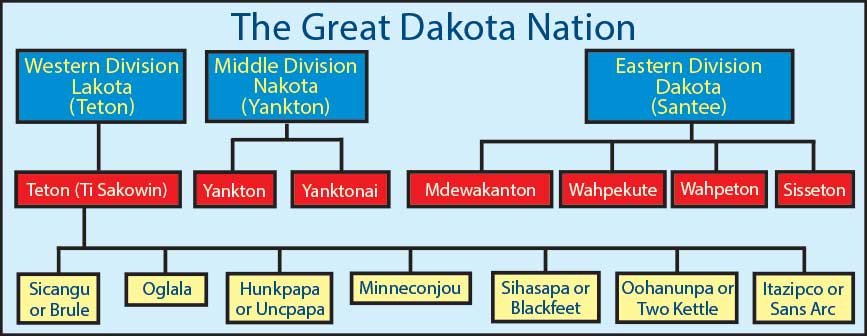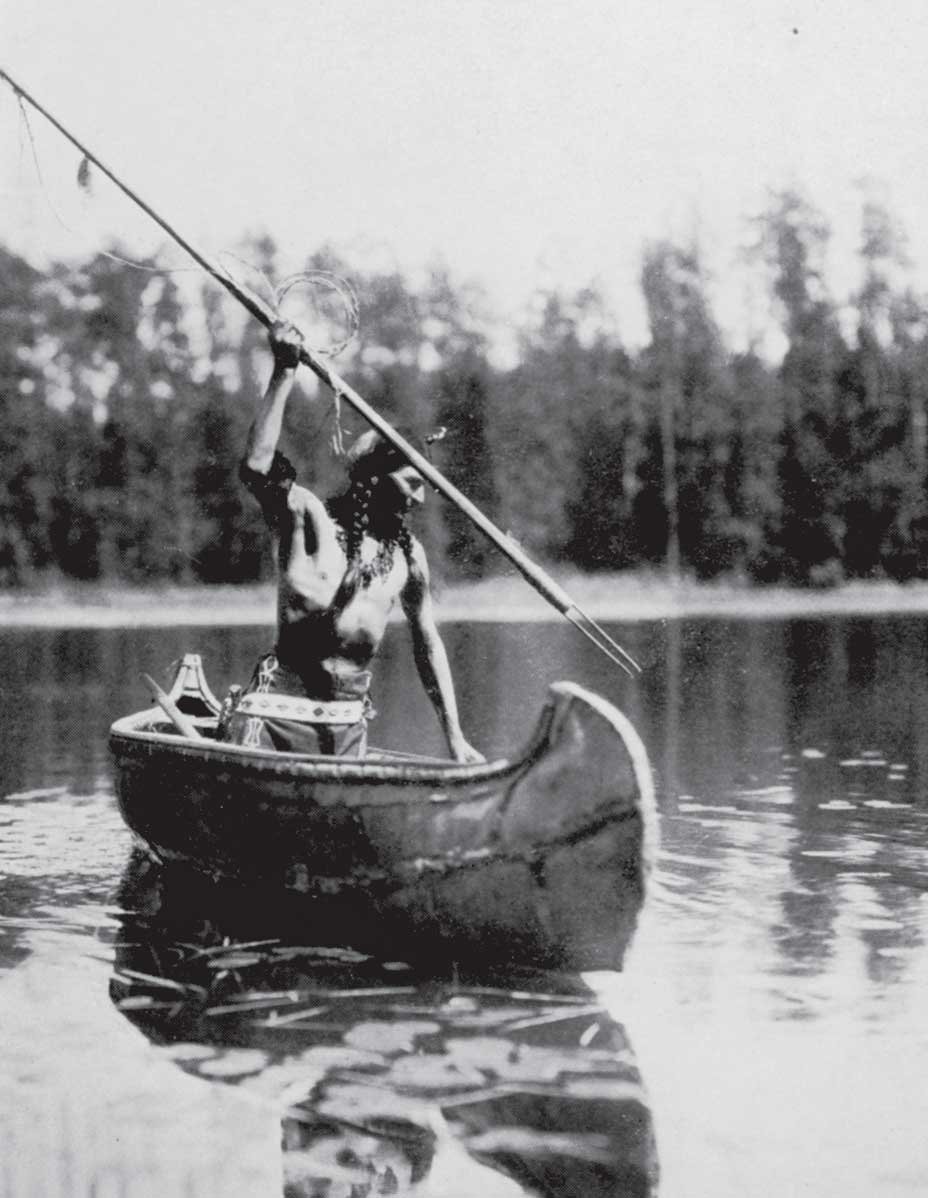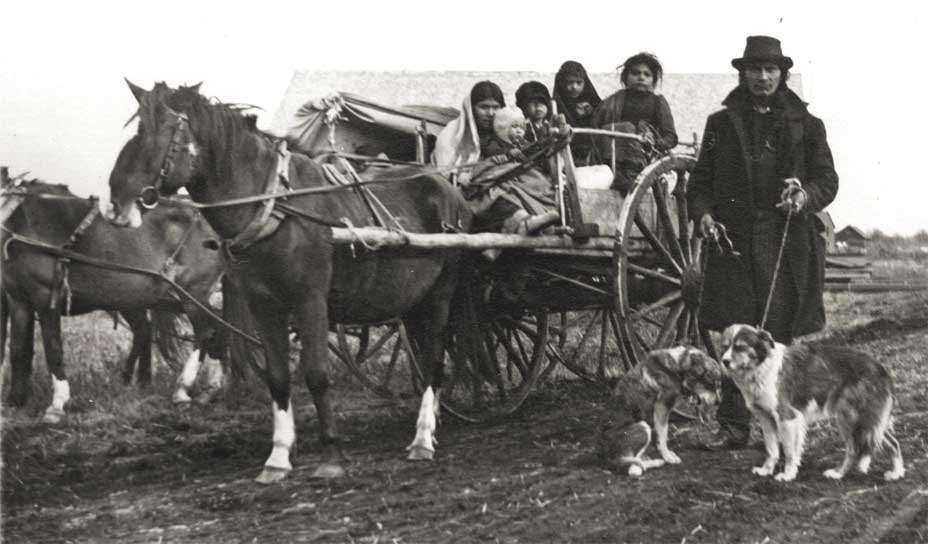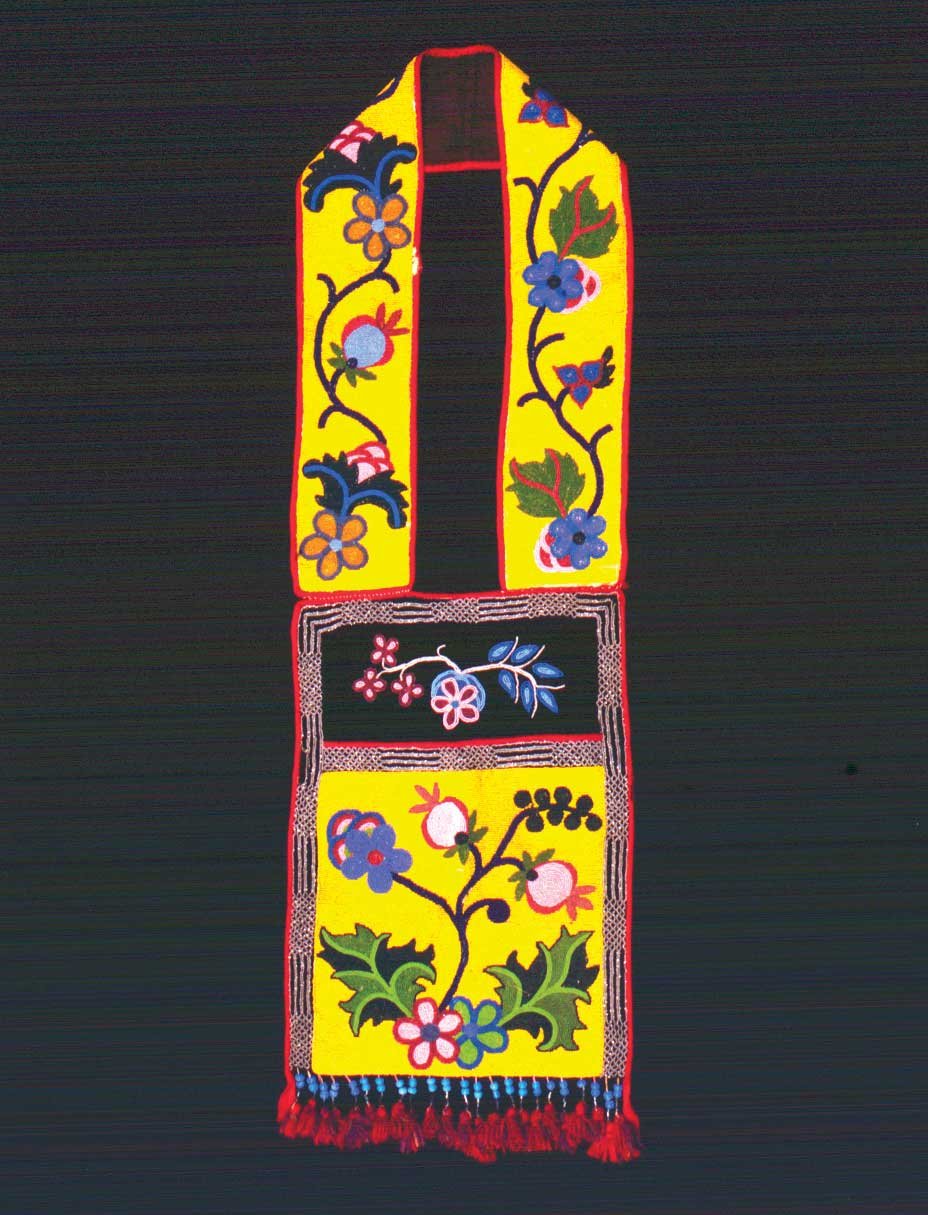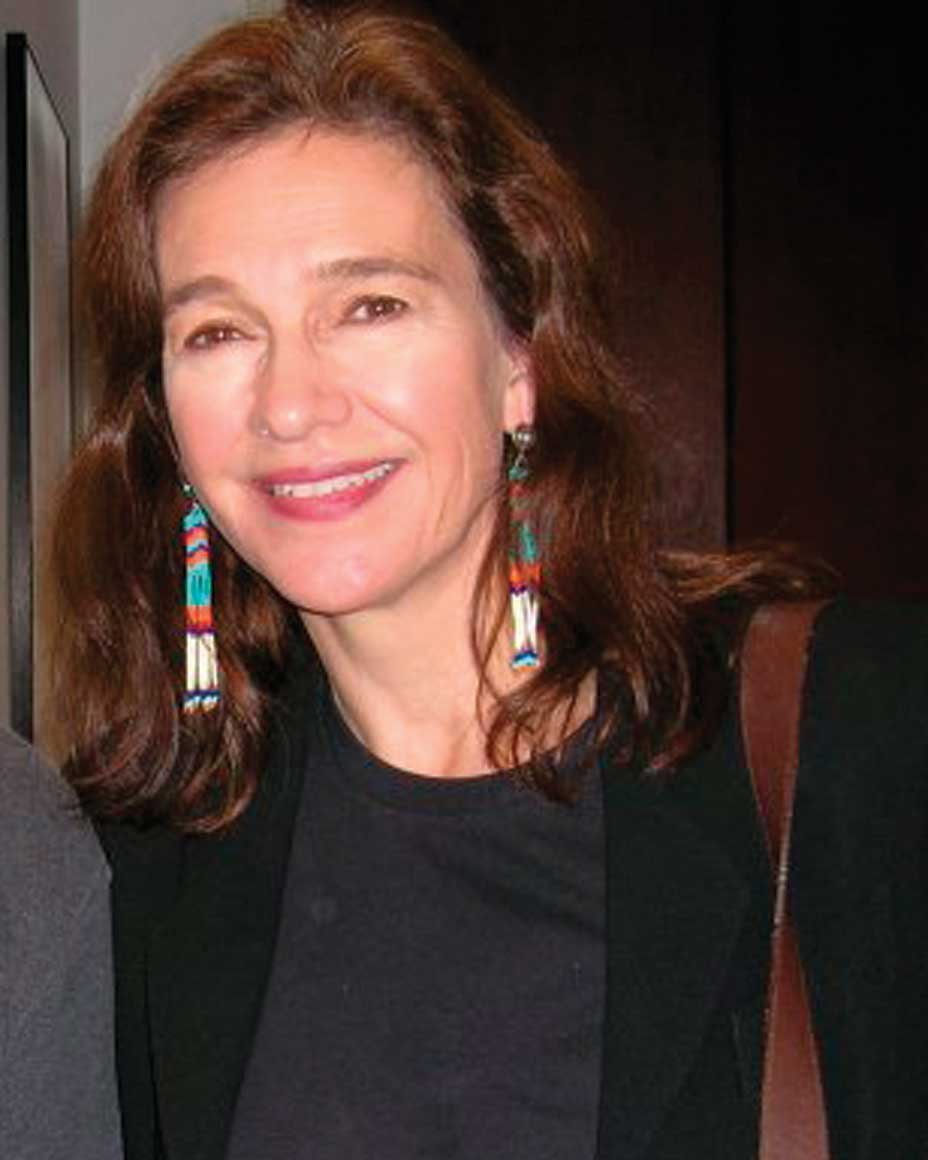
Early American History
4th Grade Curriculum — North Dakota
Part 1
Part 2
Earthlodges at On-A-Slant village on a rise above the Missouri River and near present-day city of Mandan ND. (ND Tourism, JL 217-5)
What do We Call the Early People?
Early American Indians hunted bison on a winter day in North Dakota. They took the meat back to their camp, probably hauling it with dog travois. Women dried meat on willow racks and stretched and pegged down the hides on the ground to dry. (State Historical Society of North Dakota)
Beginning with Paleo Indians in Archaic Era—about 7500 years
American Indians of North Dakota
The Archaic era began about 7,500 years ago. The changes in climate led to changes in plants and animals. The Archaic (ar-kay-ik) was a new era because people made different spear points and used new tools.
Some animals became extinct. Some animals, such as Buffalo (sometimes called bison), became smaller. People of the Archaic era adapted to these changes.
People of the Archaic era were the descendants of the people who lived in the Paleo-Indian era. As their population increased, the people continued spreading throughout the continents of both North America and South America.
Paleo-Indians butchering a giant bison at the end of the Ice Age while a mammoth looks on. A Painting on Exhibit in ND State Historic Society Building (SHSND 1996.25.1)
They lived in small bands, or groups, and
continued their nomadic way of life following herds of game animals, especially Bison and gathering plants for food.
This ancient bison skull was found near New Town ND. The skull has a horn span of seven feet. The skull is exhibited at the North Dakota Heritage Center & State Museum in Bismarck ND. (SHSND 98-44.1)
Archaeologists have found remains of the Archaic people’s culture scattered throughout the plains. A hard stone called flint was mined by people along the Knife River in North Dakota.
Spear points made of this flint were used by hunters in North Dakota and were also traded to people in other areas. Evidence of the use of flint has also been dated back to the time of the Paleo-Indians.
The atlatl (at-lat-ul) was developed for hunting by the Archaic people. This weapon was a stick with a handle on one end and a hook on the other end. With the atlatl, hunters could throw darts much harder and farther than they could throw a spear.
People of the Archaic era made knives, hammers, scrapers and other tools from flint or animal bones. Many of these stone and bone tools have been found in sites of ancient peoples’ activities in North Dakota.
Black Elk:
The Circle of Life
Black Elk in 1940. Black Elk, an Oglala Lakota medicine man, is best known for his interviews with John Neihardt, during which he talked of his religious views, visions and life events. Neihardt published these in his book Black Elk Speaks in 1932.
“You have noticed that everything an Indian does is in a circle and that is because the Power of the World always works in circles and everything tries to be round . . . The sky is round and I have heard that the earth is round like a ball and so are all the stars.
4th Grade ND Studies, State Historical Society of ND; ND Studies for schools, https://www.ndstudies.gov/gr4/
Part 3
“The wind in its greatest power whirls. Birds make their nests in circles, for theirs is the same religion as ours . . . Even the seasons form a great circle in their changing and always come back again to where they were.
“The life of a man is a circle from childhood to childhood and so it is in everything where power moves.” –Black Elk, Oglala Lakota Sioux
Woodland People
A Plains Woodland Camp Scene. Photo ND State Historical Society.
About 2,500 years ago, the people of the Woodland era came from the forests of Minnesota and Wisconsin to live in North Dakota.
The Woodland people hunted and gathered as earlier groups had done and got corn through trade. The Woodland people were the first people in North Dakota to make pottery.
The Woodland people lived mostly near rivers where they had a ready supply of drinking water. Trees and brush that grew beside the rivers provided firewood and served as habitat for game which could be hunted.
They protected their villages with walls made of upright logs.
Some of the Woodland people had houses that used wood frames covered with bison hides or grasses. The sites of a few Woodland villages have been found in North Dakota.
Another difference between people of the Archaic era and people of the Woodland era was in their burial traditions. In the Archaic era people placed their dead on platforms or under piles of rock. Some Woodland people buried their dead in the earth. After a body was placed in a grave, a mound of dirt was placed over the grave.
Sometimes weapons, tools and other
Woodland pottery. Pieces of a pot found in North Dakota (right). Also shown is a replica of the pot (left). Pottery examples are on display at the North Dakota Heritage Center & State Museum in Bismarck, North Dakota. Photo Neil Howe.
possessions were also placed in the mounds. These mounds became big cemeteries and some were used for hundreds of years. This practice earned the Woodland people the nickname “Mound-builders.”
About 1,400 years ago, North Dakota became home to the Late Woodland culture. The Late Woodland people may have been ancestors to the Mandan Indians. They lived much like the earlier Woodland people, raising crops and hunting bison, but they also depended more on fishing.
We Are All Equal
The color of skin makes no difference. What is good and just for one is good and just for the other, and the Great Spirit made all men brothers. I have a red skin, but my grandfather was a white man. What does it matter? It is not the color of the skin that makes me good or bad.
–White Shield, Arikara Chief
Notable American Indians of North Dakota
As you continue you will notice full-page tributes to notable American Indians of North Dakota.
These people include Keith Bear, Mary Louise Defender Wilson, Sitting Bull, Sakakawea, Four Bears, Cynthia Lindquist, Josephine Gates Kelly and Louise Erdrich. Please study these tributes to learn how these North Dakotans have contributed to the history and culture of our state.
By 1500, or even earlier, American Indians of North Dakota had organized into tribes, or groups of people who have a common heritage. The people of an Indian tribe share a culture or a way of life that includes language, traditions and religion.
A tribe’s oral traditions, or storytelling, help the people understand their common history and traditions. Culture makes each tribe different from all other tribes. Each tribe also identified a particular area of land where they lived and hunted.
Today there are six tribes with headquarters in North Dakota. They are the Mandan, Hidatsa, Arikara, Lakota Sioux, Dakota Sioux and Turtle Mountain Chippewa. The Lakota, Dakota, and Chippewa are related to other bands of their tribes that live in other states.
Six tribes have headquarters in North Dakota—the Mandan, Hidatsa, Arikara, Lakota Sioux, Dakota Sioux and Turtle Mountain Chippewa.
Plains Village People—Mandan, Hidatsa, Arikara
The Mandan and Hidatsa people lived in villages of earthlodges. The earthlodge was a dome-shaped home made of logs and covered with willow branches, grass and earth. The women built, owned and took care of the homes. They also owned the property within the homes, as well as the food, gardens, tools, dogs, mares (female horses) and colts (young horses).
When a couple got married, the man moved into his wife’s home. He brought only a few things along, such as his medicine bundle, clothes, weapons and horses. The men were responsible for protecting the village and hunting for meat.
Besides bison hunting, agriculture (farming) was a means of support for both the Mandan and Hidatsa. The women were the farmers.
Corn, squash, pumpkins, beans, sunflowers and tobacco were their main crops. Raising these crops provided food for the families. The crops were also used as trade items to get products from other tribes.
Each earthlodge had a hole in the ground about 3 to 4 feet deep. This was called a cache pit. It was used to store dried corn, nuts, berries and squash. The cache pit acted somewhat like a refrigerator because of the cooler temperatures below the surface of the ground.
A cache pit was used to store dried corn, nuts, berries, and squash. This shows the inside of a cache pit from a side view. Photo by Gwyn Herman.
Birds-eye view of a Mandan village. SHSND 970.1C289NL.
From 20 to 40 earthlodge homes usually made up a village. The villages became major trading centers. Money was not needed in this trading business because a system called “bartering” was used. Bartering means trading items for other items without exchanging money.
Nomadic tribes would come to the villages to get corn and other food products. In turn, the agricultural people would trade for items that the nomadic tribes had gotten by hunting or trading in other places.
During the summers, nearly the entire village would take their tipis and move out onto the plains to hunt bison. The actual hunting would be done by the men, but getting the meat ready for winter use was a job done mostly by women.
Horses came to the people of this region around 1750, but weren’t important until around 1800. The Mandan and Hidatsa probably obtained their first horses by trade with Indians of other tribes.
The Mandan, Hidatsa and Arikara learned that horses made hunting easier. Horses were also important in defending the village. They became important trade items and were often stolen by enemies.
Warriors from one tribe would often raid other tribes in order to take their horses.
Keith Bear—Three Affiliated Tribes
Keith Bear, a member of the Three Affiliated Tribes, is a flute player known all over the world. He uses his flute to tell stories.
Keith started his life being raised by his mother and relatives in the Sioux and Mandan cultures. Before he started first grade, he was placed in a foster home and between the ages of 6 and 12, lived in 14 different non-Indian foster homes.
After Keith grew up, he was working in the Wyoming oil fields. Another worker carved a flute out of wood and gave it to him.
Because the Missouri River was a major travel route, the agricultural villages along the river were an ideal setting for trading. In fact, this area became one of the largest trading centers on the continent. It has been called “The Marketplace of the Central Plains.”
Trade with non-Indians changed the Indians’ way of life in many ways.
Spear heads and arrow points could now be made of metal instead of chipped stone. Cloth could be used in place of hides to make clothing and blankets and colored glass beads could be used for decorations on clothing instead of the porcupine quills that had been used before.
Trading was done within the villages and forts
World renowned flute player, Keith Bear, Hidatsa and Mandan, is from the Three Affiliated Tribes in Fort Berthold ND.
Keith carried this flute around for two years before he got interested in playing it. At that time, he had a drinking and drug problem and did not know what he wanted to do with his life.
One day, Keith realized that he wanted to change his life. He took his flute out to a hill and stayed there for three days and three nights while he sobered up for good.
As the wind blew through the flute, it made a low tone and the rustling leaves added to the sound. Keith thought this was a gift from the Creator.
When he came down from the hill, Keith started playing his flute. At first, only sour‐sounding notes came out, but the more he practiced, the better it sounded. After about a week of steady practicing, he played his first song.
Keith’s uncle taught him how to carve his own flutes and over the years, Keith has made many different kinds, each with its own special sound.
He is also a storyteller and sometimes dresses in his regalia when he performs. He has played music with many famous orchestras, including the National Symphony in Washington, D.C.
Keith has proved that even if people have not had the best of childhoods, they can turn their lives around if they want to.
Today, Keith Bear is famous, not only in the United States, but also throughout many parts of the world. He has won awards for his music and performances and he has also acted in a movie.
He believes that all humans were created by the same Creator and everyone has a connection with everyone else. Flute music is the wind that breathes life into the heart.
On-A-Slant village was built about 400 years ago near what is now Mandan, where the Heart runs into the Missouri River. Photo by Gwyn Herman.
About 400 years ago, the Mandan people from some nearby villages got together and built a new village beside the Missouri and Heart Rivers, near the present-day city of Mandan ND. They called this village On-A-Slant because it slanted toward the Heart River. About 75 lodges were located in the village and its population was about 1,000.
In 1738 (about 280 years ago), a French fur-trapper and trader named Pierre La Vérendrye (lah ver-ON-dree) came to North Dakota from Canada. La Vérendrye was among the first non-Indians to set foot in North Dakota. He wrote in a journal about his experiences and so became the first Euro-American to record history in this area.
La Vérendrye spent some time visiting and trading with the Mandan people along the Missouri River. He estimated that their population was about 15,000 and reported that they were very peaceful people.
Some years after La Vérendrye’s visit, other Europeans and Euro-Americans began trading with the people in North Dakota. They brought metal tools, cloth, beads, rifles, kettles and other manufactured goods to trade for garden crops, meat, furs and other items.
Horses were a big advantage in hunting and war and were highly valued by the Plains Indians. The horse was also used for trading. This poster shows the items that could be traded for one and two horses. SHSND-ND Studies.
were also set up as trading posts. Corn, bison hides and beaver pelts were considered very valuable by Europeans and Euro-Americans and commerce became a huge business.
At the same time that commerce was becoming more important, something dreadful happened that had a tragic impact on the Indian people.
The natives of North America had never been exposed to deadly diseases that had been in Europe for hundreds of years or more. Therefore, they had no natural immunity from diseases such as smallpox, measles and typhoid fever.
In 1781, a severe smallpox epidemic occurred in the villages. This horrible killer reduced the population of the Mandan Indians from about 12,000 to about 1,500 within a matter of just a few months.
Mandan horse races—the finish line. SHSND 970.1.
On-A-Slant village, which had existed for about 200 years, was almost totally wiped out.
Another village, on the present-day historic site called Double Ditch Indian Village near Bismarck, had been occupied for almost 300 years and when the epidemic struck, most of the residents died.
After the villages were weakened by disease and death, the Lakota attacked. The attacks caused the remaining people to move north, closer to the Hidatsa. The Hidatsa also lost many people to smallpox.
In the 1700s, the Arikara (ah-rick-ah-rah), or Sahnish, people came from the south and settled along the Grand River, a tributary of the Missouri. During the early 1800s, they moved northward along the Missouri River.
When the smallpox epidemic hit, their population was reduced from about 20,000 to only about 4,000. In about 1825, they continued up the Missouri River and settled near the Mandan and Hidatsa villages.
The Mandan and Hidatsa people were somewhat alike in their lifestyles and languages. The Arikara had a very different culture, but they lived in earth lodges in permanent villages. They raised crops and were traders. All three tribes benefitted from this close relationship.
In 1837, a steamboat docked at the Fort Clark trading post near the present-day town of Washburn ND. A man on the boat was sick with smallpox and the illness had spread to others on board.
By the time the steamboat reached Fort Clark, it contained several men with smallpox. When Indians came aboard the boat to trade, they were exposed to the illness. Though a warning was sent to other camps and tribes, the disease spread rapidly among the Indian tribes.
In 1845, the Mandan and Hidatsa people started a village together on the Missouri River north of their old villages. The area of land where they built this town was in a bend of the river that reminded them of a fishhook. They called this village “Like-A-Fishhook.”
In 1862, the Arikara joined them. All three tribes had lost so many people in the smallpox epidemics that they felt it was necessary to band together to protect themselves against nomadic tribes that were raiding their villages.
Entire families as well as entire villages were wiped out by this disaster. The population of the Mandan people was reduced from about 2,500 to only about 125 people. More than half of the Arikara people died, leaving their population at about 1,500. The Hidatsa were also hard-hit.
Smallpox was a disease that affected Europeans for hundreds of years. It came to North America with the colonists. Europeans often died of the disease, but those who recovered became resistant or immune to another infection. American Indians had no immunity at all.
In the 1820s, an English doctor developed a
Like-A-Fishook village, named for its location at a sharp bend in the Missouri River, was built by the Mandan and Hidatsa. The drawing is by Martin Bears Arm. SHSND 799.
vaccine for smallpox. The vaccine helped prevent the disease in people who were given the vaccine.
In the 20th century doctors and scientists made a major effort to wipe out smallpox. They were successful. Today smallpox is a disease of the past and no one can get the disease.
Even though the three agricultural tribes were alike in some ways, they each had their own language, as well as other cultural differences, so each tribe lived in its own section of the village. The Mandan, Hidatsa and Arikara groups became known as the Three Affiliated Tribes.
In 1851, a treaty with the U.S. government set aside twelve million acres of land as a reservation for the Three Affiliated Tribes, but unfortunately, the government later took away most of this land, leaving the Tribes with only about a half-million acres.
Plains Nomadic People—followed Bison Herds
After a time, other Late Woodland groups moved into North Dakota. The Plains Nomadic
people probably came from forests in the east. They did not have permanent homes but traveled in small bands following bison herds.
The Plains Nomadic people left traces that show they lived in all parts of North Dakota. They may have been ancestors of the Sioux (soo), or Dakota, Indians. Another Late Woodland group that came from the east may have been ancestors of the Chippewa Indians. The Chippewa continued the lifestyle of the Woodland people.
Evidence has been found that the Woodland and Plains Nomadic people did a lot of trading
Mary Louise Defender Wilson
The Lewis and Clark Expedition visited Black Cat village in 1806.
with other groups. The first metal used by people in this area was copper, probably from Minnesota. It was made into knives, axes and jewelry.
Seashells from both the Atlantic and Pacific coasts were uncovered at archaeological sites in North Dakota and Knife River flint has been discovered in sites hundreds of miles from where it originated.
Mary Louise Defender Wilson
Mary Louise Defender Wilson is a storyteller who has become famous throughout the United States among both Indians and non-Indians. She is a member of the Standing Rock Sioux Tribe and also is part Hidatsa.
Mary Louise Defender was born in Shields ND on Oct 14, 1930. Her family raised sheep and gardened.
At a young age, she learned storytelling from her mother, grandparents and other members of her extended family. She has become famous throughout the United States among both Indians and non-Indians. A member of the
Standing Rock Sioux Tribe, she also is part Hidatsa.
They told stories, not only for entertainment, but also to educate both children and adults.
By the age of 11, Mary Louise was already a good storyteller. She could speak three languages—Dakotah, Hidatsa and English.
The stories she had heard from her family and from the elders of her tribe were stored in her memory and she began passing these stories along to other people.
Mary Louise married William Wilson, a Navajo (nav-a-ho) Indian. He introduced her to Navajo elders who also told stories. When she returned to Standing Rock, she asked the Sioux elders to teach her even more stories.
Animals were a big part of many of the tales. They taught lessons about kindness, sharing, helpfulness and other important values.
Today, Mary Louise is an elder in the Standing Rock Sioux Tribe. She has been a teacher and has also worked to educate teachers and others about American Indian culture.
She is very wise and uses her wisdom in ways that will help preserve traditions of the Indian people. Her goal is that all people respect each other and respect all life.
Mary Louise has won many awards throughout the United States for her storytelling ability. Many of her tales are now available on CDs and YouTube so that everyone can have a chance to hear the charming voice and the delightful stories of this great person.
From coast to coast, one of the best storytellers in America is Mary Louise Defender Wilson.
Archaeological Sites
An archaeological site is a place where archaeologists find evidence of people who lived long ago. These people did not record their history on paper, so archaeologists look for other signs of their cultures.
Evidence might include stone or bone tools, pottery, burned wood from the hearth (fireplace), shell jewelry or tools, or a burial. Archaeologists might find these things on top of or below the ground. They are careful to treat the objects respectfully.
In the time of pre-history, people reported on events and spread information by talking and telling stories. For the American Indians, storytelling was a ceremony that made the word sacred. The stories had to be told exactly the same way every time.
In this way, information was passed from generation to generation (parents to children, grandchildren, etc.). Passing on information this way is called oral history.
Another way of holding onto memories was by using pictures and other forms of art. Examples are carvings on rocks, pictures on tipis and “winter counts.” The men did the pictographs, or picture-writing, because they were keepers of the tribe’s history.
Winter counts were calendars and records of history that were made by many of the Plains tribes. Each winter, a special event from that year would be selected.
A picture would be painted on an animal hide or piece of cloth. A storyteller would use this as a memory aid to help in telling the story of the tribe’s past. Being the “Keeper of the Winter Count” was an important responsibility.
A winter count might also be called a pictograph. When groups used pictographs and other forms of written language, information could be saved and spread to more people than could be done by the spoken word alone. A written record of past events is called history.
Winter count by Swift Dog. SHSND 674.
“Dakota” means “friend.” Thousands of people made up The Great Dakota Nation.
They occupied parts of Minnesota, South Dakota and other areas west of the Mississippi River.
The Chippewa Indians, enemies of the Dakota, called them “adders” (an adder is a type of snake). When the French traders tried to say this word in the Chippewa language, they could not say it correctly and it came out sounding like “Sioux” (soo). This name became commonly used for people of The Great Dakota Nation.
The Chippewa had made friends with the French who gave them
guns and helped them in their battles. In time, the Chippewa began pushing the Sioux people out of Minnesota and into North Dakota.
The Great Dakota Nation—
Lakota, Nakota, Dakota
The Great Dakota Nation was divided into three separate groups, each having its own culture and language patterns. The three groups were the Lakota (or Teton), Nakota (or Yankton), and Dakota (or Santee). A large northern area west of the Mississippi River was named after The Great Dakota Nation. It was called Dakota Territory.
Timeline: American Indians of North Dakota
This timeline shows events from 25,000 years ago through European contact and two ND smallpox epidemics.
American Indians of North Dakota
The largest group of the Great Dakota Nation was the Lakota Sioux, who were made up of seven major tribes. The Lakota people were taller than most other people at that time. Many of their warriors were over six feet in height.
The Lakota became expert horsemen. Hunting bison was their main source of livelihood, but they also raided other tribes to get more horses and other items that they wanted. They claimed a very large hunting area ranging hundreds of miles from Oklahoma into Canada. All of the Sioux tribes were nomadic, but the Lakota were the most nomadic of the three groups of The Great Dakota Nation.
Millions of bison lived on the plains and these huge animals were very different from the forest animals that had been hunted in the woodlands of Minnesota. In fact, the survival of the plains people depended on hunting bison. They used every part of the animal, not wasting anything. The bison has been called “a walking department store” because so many items came from this animal. Food, shelter, clothing, weapons, tools and musical instruments are a few examples of products that were made from the bison.
Millions of years ago, tiny, three-toed horses lived in North Dakota. They became extinct
The Great Dakota Nation (about 1822) consisted of three separate groups—the Lakota (or Teton), Nakota (or Yankton), and Dakota (or Santee). SHSND-ND Studies.
The Dakota Sioux moved into North Dakota from Minnesota after conflicts and battles with both white settlers and U.S. soldiers. Four tribes made up the Dakota group.
Like the Lakota, the Dakota traveled long distances on horseback to hunt and to raid other tribes. The nomadic tribes lived in tipis, so it was easy for them to pack and move to another place when the bison herds would move on.
The Nakota Sioux were pushed west by the Chippewa. They were divided into two tribes that settled in South Dakota and the southern part of North Dakota. Many of them built permanent homes like the ones they had left in Minnesota. Hunting bison became a central part of their lives, but many people also raised corn, squash, and other vegetables.
The nomadic tribes lived more out in the open than the tribes who lived close together in permanent villages. For this reason, when the smallpox epidemics came, the disease did not spread among the Sioux as much as it spread throughout the agricultural people in villages. In fact, when the Mandan and Hidatsa were losing thousands of people to smallpox, Sioux warriors raided the villages and killed even more people.
The Indians of The Great Dakota Nation had been woodland people who had hunted, fished, and sometimes farmed. When they moved to the plains, they had to change their way of life from a woodland culture to a plains culture.
Chart shows the 3 major divisions of the Great Dakota Nation, and how each is then also split into bands. SHSND-ND Studies.
The bison provided food, shelter and clothing, as well as skulls and bones for religious ceremonies of the Plains Indians,. Some called the animal “A Walking Department Store.” SHSND-ND Studies.
millions of years before modern horses arrived. Modern horses did not live on the continent of North America until people from Spain brought them to the southern part of the continent in the 1500s.
They slowly spread northward as they were traded from tribe to tribe until the horses reached North Dakota toward the end of the 1700s. After the Indians got horses, they were able to travel long distances which made the bison hunting much easier.
It has been estimated that before 1800 about [30 million] bison roamed the plains. The Sioux, as well as all of the other Indians of the plains, had lived for many years being totally dependent on the bison.
Because North America was the only continent where bison lived, Europeans had never seen such an animal. When traders began sending bison robes to Europe, the robes became so popular that the traders could not keep up with the demand.
In the 1800s, millions of bison were killed. Bison hide traders, farmers, railroad companies, sport hunters, and the U.S. Army all had a part in reducing the bison herds. Wagon load after wagon load of bison robes were hauled away to be sold in the east or shipped to Europe. Farmers wanted the bison gone so that they could raise crops and build fences for their cattle. Railroads were being built across the continent, and the railroad companies wanted to bring in more settlers so that they would get more business.
Bison herds were in the way of settlement, so railroads hired people to shoot the animals. The U.S. Army wanted the Indians’ food supply removed so that the Indians would move to reservations. Hunters came from the east to shoot bison just for sport. Most of the bison meat and other parts were wasted by these whites.
Because of all of these wasteful killings, the magnificent bison became almost extinct. It has been estimated that by 1890, only about 500 bison remained in North America.
The loss of their food supply led to the defeat of the Lakota and other plains tribes. The bison had not only served as the source of their food, but it had also been a sacred animal for them. With its disappearance, they lost a great source of their spiritual strength.
Sitting Bull
Sitting Bull was a Lakota leader and medicine man who became one of the most famous American Indians in the world. He was born around 1831. When he was about 14 years old, he proved his bravery in a battle, and that was the beginning of his career as a warrior.
Sitting Bull’s goal was to protect his people and and their lands from “whites” who were moving onto Indian lands and killing off the bison. In 1876, Lakota and Cheyenne families gathered at
The Standing Rock Sioux Reservation is located about 40 miles south of Mandan ND and extends into South Dakota. The ND part of this reservation is located almost entirely in Sioux County, the only county in the state that is entirely reservation. Most of the land has rolling hills and grasslands that are good for ranching and farming.
The Cannonball River runs along the north side of the reservation and Lake Oahe on the Missouri River forms the eastern boundary. Lake Oahe was created when a dam was built in South Dakota on the Missouri River.
The dam was finished in 1962 and 50,000 acres of fertile bottomland and timber were permanently flooded when the lake was formed.
Chief Rain-in-the-Face was a traditional Lakota leader from the Standing Rock Sioux Nation. He was a brave warrior who stood firm to prevent the senseless killing of bison and other game. Rain-in-the-Face was also a key leader at the Battle of the Little Bighorn in 1876. (Standing Rock Sioux Tribal Council)
Sitting Bull was the leader of the Hunkpapa band of the Lakota and widely respected leader in the Lakota Nation. Photo Standing Rock Sioux Tribal Council.
the Little Big Horn River in Montana. In June, army troops led by George Custer from Fort Abraham Lincoln (near present-day Mandan, North Dakota) attacked, but the Lakota warriors defeated Custer’s army, killing Custer and most of his soldiers.
After Custer’s defeat, the U.S. Army began attacking all Indians who were not on reservations. Sitting Bull led his followers to Canada for safety. In 1881, Siting Bull surrendered to save his people from starvation. He and his people were sent to the Standing Rock Sioux Reservation.
Sitting Bull became famous because of the battle with Custer, so he was asked to join “Buffalo Bill’s Wild West Show.” He agreed because he wanted to earn money to help his people. He stayed with the “Wild West Show” for four months and earned good pay, but he missed his home and family at Standing Rock.
A few years after Sitting Bull returned to Standing Rock Reservation, a new religion called the “Ghost Dance” came to the Lakota. Ghost Dancers believed that if they danced and followed the beliefs of the Ghost Dance that the bison would return.
The reservation agent feared the power of the Ghost Dance and Sitting Bull’s influence on the unhappy Lakota. The agent sent Indian police to arrest Sitting Bull. His followers resisted and there was a fight. Sitting Bull was shot and died.
Sitting Bull is honored today as one of the greatest leaders of the Lakota Nation.
Chippewa
The Chippewa, or Ojibwa, people came to North Dakota from the forests of Wisconsin and Minnesota. They lived in wigwams most of the time, but during the summers when they hunted bison, they used tipis, which could be set up and taken down quickly.
The Chippewa were good fur trappers and traveled along rivers to trap beaver for trade with Euro-Americans. They used the birch-bark canoe for fishing and traveling on rivers and lakes. These canoes had high ends and sides so that even in rough or choppy water, the water did not come in easily. Birch-bark canoes were
Left: Birch-bark canoe. The Chippewa used the birch-bark canoe for fishing and travel. SHSND 053-04.
Below: A Chippewa/ Métis family shown with a Red River cart. Red River carts were equipped with high wheels that traveled well on prairie sod, similar to the peasant carts the fathers and grandfathers had known in France. SHSND A2472-2.
Map of Red River cart trails hauling their bison hides and pemmican to Winnipeg and St Paul for trading. SHSND-ND Studies.
very strong, but they were light enough to be carried on land.
The Chippewa Indians organized themselves into groups called “bands,” which were named after the area in which they lived. A main chief led each band, and he was assisted by lesser chiefs.
A tribal council made sure the chiefs were carrying out their duties. After the death of the main chief, his son would take over and act as chief for the rest of his life. However, if the chief was not doing his job properly, the council could replace him with someone else.
Each band was divided into “clans,” named after animals, birds, or fish. The clans were made up of several families who seemed like one big family. They would look after each other and help each other out. People were not allowed to marry anyone in their own clan.
Before 1800, groups of Chippewa had come to eastern North Dakota. These people trapped and traded in the Pembina area, so they called themselves the Pembina Band.
After a few years, so much trapping had been done in eastern North Dakota that the population of fur-bearing animals was very low. In order to be successful in their business, the Chippewa needed to move farther west.
A group settled in the Turtle Mountains and called themselves the Turtle Mountain Band. In this hilly region of lakes and trees, animals such as fish, beaver, muskrat and deer were plentiful.
Because the Chippewa had gotten horses in the early 1800s, they were also able to hunt bison successfully. The Chippewa not only continued their commerce at the Pembina trading post, but they could also travel great distances to trade with other tribes. The Chippewa people adapted well from the woodlands to the plains.
Many Chippewa women married French or Scottish fur traders. Their children, who were half Chippewa and half French or Scottish, were called Métis (may-tee).
The Métis people usually thought of themselves as Indian, but their culture was a mix of Indian and European traditions. They were known as good bison hunters and fur traders. They developed a two-wheeled cart pulled by oxen or horses. These carts were called Red River carts.
They could carry huge amounts of bison hides and other goods to major trade centers such as St. Paul, MN and Winnipeg, Manitoba.
During the late 1800s, the Turtle Mountain Band faced many hardships. Euro-American settlers were moving onto Chippewa lands, and the bison, the Chippewa’s main source of food, became almost extinct on the plains.
During the winter of 1887–88, over 150 members of the Turtle Mountain Band of Chippewa starved to death.
Reservations in North Dakota
The Standing Rock Sioux Reservation is home to Lakota and Dakota Sioux people. The reservation was set up for the Standing Rock Sioux Tribe in 1889. Before that, it was part of a large reservation that was broken up by the government to allow for white settlement.
Josephine Gates Kelly
Josephine Gates Kelly believed she could make a difference in the lives of the Indian people, and she became an outstanding leader. Her goal was to help her people, which she did, but she also made history.
Josephine Gates was born January 24, 1888, and was raised on the Standing Rock Sioux Reservation. She was the first woman from Standing Rock to graduate from Carlisle (car-lyl) Indian School in the state of Pennsylvania. She married Covin Kelly in 1920, and they had six children.
In 1940, Josephine was elected to the Standing Rock Tribal Council. Her leadership abilities were so good that in 1946 she won an election that made history. Josephine
Louise Erdrich (air-drik) is one of the most famous authors of our time. She was born in 1954 to a Chippewa mother and a German-American father. Her grandfather had been a tribal chair on the Turtle Mountain Reservation. Louise is a member of the Turtle Mountain Band of Chippewa.
When Louise was young, she heard so many stories told by her large extended family that she became interested in writing stories. Her parents liked her stories so much that her father paid her a nickel for every story she wrote, while her mother made covers for her “books” out of construction paper.
Standing Rock Monument is located near the entrance to the Standing Rock Tribal headquarters in Fort Yates, North Dakota. Neil Howe.
Today, Lake Oahe attracts tourists as a water recreation area. Many picnic areas and campgrounds are available near the lake.
The tribal headquarters of the Standing Rock Sioux Reservation is at Fort Yates. Most of Fort Yates is situated on a peninsula of Lake Oahe.
Two tourist attractions at Fort Yates are Sitting Bull’s gravesite and the Standing Rock monument. An old Dakota story said that an Arikara woman married a Dakota man. This man later married another woman and the first wife got jealous.
When the rest of the band left the camp, she refused to leave. Two men who came back to get her found that she had turned to stone. The Standing Rock monument reminds people of this story.
Fort Yates is also the location of Sitting Bull College. This college, which was first called “Standing Rock Community College,” began offering classes in 1973. It now offers four-year college degrees.
Farming and ranching are the major means of support on the Standing Rock Sioux Reservation, but several hundred people are also employed by the tribe.
Prairie Knights Casino and Resort is a successful tribal business. It consists of an entertainment center, hotel, RV park and other attractions that bring people to the area.
In spite of these opportunities, the Standing Rock Sioux Reservation still has a shortage of jobs, so many people struggle to make a living. Many tribal members have left the reservation to find better jobs.
It is important to the Sioux people that their children receive a good education, including being taught their traditional language and culture. The elders share the rich traditions that have been handed down to them and the young people can carry these gifts into the future with pride.
Tribal Headquarters building for the Standing Rock Sioux at Fort Yates ND. Neil Howe.
Josephine Gates Kelly was the first woman in US to be elected Tribal Chair. SHSND 1952-5040.
Gates Kelly became the first woman in the United States to be elected Tribal Chair.
The U.S. government had planned on putting the Standing Rock Indian agency together with another Indian agency, but the Standing Rock Tribe opposed this action. They thought it would weaken their tribal rights.
Tribal Chair Josephine Gates Kelly traveled to Washington, DC to fight for fair treatment of the Standing Rock Tribe. She was successful in her efforts and the Standing Rock Tribe was able to keep their rights.
In the early 1950s, Josephine helped establish a memorial for Indians killed while serving in the United States Armed Forces. This memorial is located in Valley Forge, Pennsylvania.
After serving three terms as Tribal Chair, Josephine Gates Kelly remained active in politics and government. She worked for the rights of not only the Standing Rock Sioux Tribe, but for all Indians, and earned the nickname “Champion for Indian Rights.” She died in 1976.
Turtle Mountain Reservation
The Turtle Mountain Reservation is home to the Turtle Mountain Band of Chippewa. Located in the Turtle Mountains near the Canadian border, it is close to the International Peace Garden.
The land in this region was shaped by glaciers which left rolling hills and many lakes and streams. The area also has a lot of trees.
A treaty was signed in 1863 that established the Turtle Mountain Reservation. In 1882, the size of the reservation was reduced to a rectangular area measuring just 12 miles east-to-west by 6 miles north-to-south.
The US government had not counted the Métis as part of the Chippewa population at that time, so the reservation was much too small. In order to meet the needs of all the people,
A Chippewa bandolier. Warriors wore the bandolier across the shoulders and used the pockets to carry ammunition. SHSND 870.
an area about 250 miles west of the Turtle Mountain Reservation was later established.
This region is called the “Trenton Service Area” and provides services mostly for Chippewa and Métis people. Part of this Indian service area extends into Montana.
In Canada, the Métis are considered a separate tribe, but in North Dakota they are part of the Turtle Mountain Band of Chippewa.
Through the years, many of the Métis developed their own lifestyles which blended parts of both the Indian and the French cultures. They dressed in a combination of Indian and European clothing and their language was influenced by both of their cultures.
Sketch of a Métis campsite. Notice the Red River carts with their two large wheels next to each tipi. SHSND C0621.
The only town on the Turtle Mountain Reservation is Belcourt, the largest Indian community in North Dakota. The tribal headquarters of the Turtle Mountain Band of Chippewa is located in Belcourt. Many Turtle Mountain Chippewa live in other towns nearby.
The Turtle Mountain Chippewa Indian Heritage Center near Belcourt is a museum complex which features displays showing the history and special culture of the Turtle Mountain Band of Chippewa Indians.
Besides the exhibits, articles are offered for sale, including craft and beadwork items, as well as supplies for arts and crafts. A library and outdoor cultural park are also part of this complex.
The well-educated and hard-working Chippewa own many successful businesses both on and off the reservation. The Belcourt area is home to Turtle Mountain Community College, a manufacturing plant, a watch factory, a shopping mall, a hospital, and other businesses.
Sky Dancer Casino and Resort is an entertainment center that includes a hotel and a restaurant. The second oldest Indian-owned radio station in the United States, 88.5 FM Public Radio (KEYA), is located in Belcourt.
Louise Erdrich
Dream Catcher
An ancient Chippewa tradition
The dream net has been made
For many generations
Where spirit dreams have played.
Hung above the cradleboard,
Or in the lodge up high,
The dream net catches bad dreams,
While good dreams slip on by.
Bad dreams become entangled
Among the sinew thread.
Good dreams slip through the center hole,
While you dream upon your bed.
This is an ancient legend,
Since dreams will never cease,
Hang this dream net above your bed,
Dream on, and be at peace.
Louise Erdrich, noted author. www.eyeonbooks.com
After growing up in Wahpeton, North Dakota, Louise went to the East Coast to attend college. She continued with her writing but also worked at other jobs in order to make a living. She has worked as a waitress, lifeguard, construction flag person and poetry teacher at a prison. She also taught writing to young people.
Louise was married and is the mother of six children. She used her background to blend Indian concerns into her magazine articles, poems and books. Her books became popular and she was able to devote all of her time to writing. Many of her books deal with serious issues, but Louise still blends humor into her writings.
She has stated that because Indian people have such a great sense of humor, it is one of the most important parts of American Indian life and literature.
Today, Louise Erdrich is a successful author who has written many award-winning books. Some of the most famous ones include Love Medicine, The Beet Queen, and The Bingo Palace. She also has authored a children’s book called Grandmother’s Pigeons.
In 2013 Louise Erdrich was presented with the Theodore Roosevelt Roughrider Award. The award recognizes present and former North Dakotans for their contributions to the state.
Further study, activities: https://www.ndstudies.gov/curriculum/4th-grade/american-indians-nd




